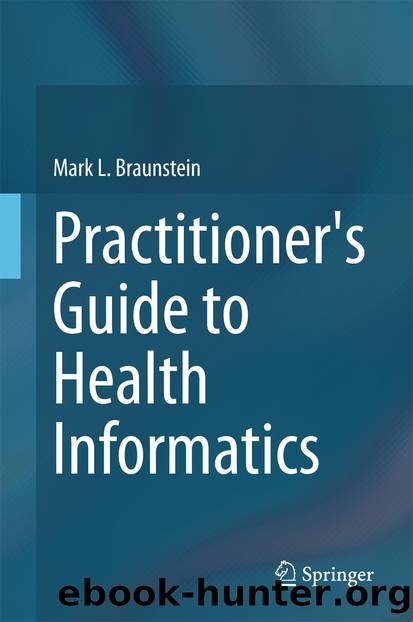Practitioner's Guide to Health Informatics by Mark L. Braunstein

Author:Mark L. Braunstein
Language: eng
Format: epub
Publisher: Springer International Publishing, Cham
This highlights at least two important benefits: It saves time by incorporating new capabilities directly into the physician’s workflow, thus encouraging use of new tools, such as CDS. It also avoids any potential errors that might be caused by duplicate entry of existing data. As a result of these potential benefits FHIR adoption is growing quite rapidly, according to Grahame Grieve. Organizations can post their interest on the FHIR site.9
Before we discuss FHIR in more detail, you may be wondering what a web service is. To illustrate this as clearly as possible in nontechnical healthcare terms, we’ll use an interesting service provided by a company called Human API.10 As you know, a patient’s provider-recorded medical data can be stored in more than one place, particularly if the patient has multiple chronic diseases being cared for by several providers. However, there are also many other places patient data may be stored and from which it can be accessed. For example, lab test results may be directly available from the company that did the tests. Increasingly patients may be recording data using mobile, wireless or wearable devices or by using an app on their smartphones. It would obviously be desirable for providing well-integrated and coordinated care, to pull all of this data together to create a clear, quantitative picture of an individual’s health. Human API does this aggregation and makes the aggregated data available via simple web services. In addition to technical issues in meshing data from disparate sources, obtaining permission to access data can be an obstacle. As we’ve discussed, many have proposed that an answer might be to let patients control their own data and make sharing decisions directly. That’s the basic idea behind Human API.
The company aggregates data from a growing list of wearable and other devices, other web sites and health-related apps. The current data sources are listed on the Human API site which also solicits suggestions for additional data sources from its visitors.11 They then normalize the data, a process that is conceptually similar to mapping it into a standard data model such as the one being developed by FHIR. However, their service precedes FHIR and is patient-, rather than provider-facing and currently uses its own model. Patients can then give permission for their physician or any other interested person or entity to access all or part of their data via a Representational State Transfer (REST) API. Figure 4 shows a part of how that actually works technically. Data is retrieved using a GET statement which does what you would expect—it fetches data from a remote database. You should also pretty easily be able to see what each of these three alternate GET statements for retrieving blood pressure readings do.
Figure 4: Human API’s defined GET statements are different queries for blood pressure. Note that they are essentially human-readable. Implementation is relatively easy and fast facilitating use of the data. (Courtesy Human API, All Rights Reserved)
Download
This site does not store any files on its server. We only index and link to content provided by other sites. Please contact the content providers to delete copyright contents if any and email us, we'll remove relevant links or contents immediately.
| Administration & Medicine Economics | Allied Health Professions |
| Basic Sciences | Dentistry |
| History | Medical Informatics |
| Medicine | Nursing |
| Pharmacology | Psychology |
| Research | Veterinary Medicine |
Undoctored: Why Health Care Has Failed You and How You Can Become Smarter Than Your Doctor by Davis William(1002)
The Creative Destruction of Medicine by Eric Topol(785)
Big Data Analysis for Bioinformatics and Biomedical Discoveries by Ye Shui Qing(736)
Participatory Healthcare by Jan Oldenburg(704)
Mistreated: Why We Think We're Getting Good Health Care and Why We're Usually Wrong by Robert Pearl(672)
Secondary Analysis of Electronic Health Records by MIT Critical Data(619)
Biomedical Informatics by Edward H. Shortliffe & James J. Cimino(611)
Wheat Belly (Revised and Expanded Edition) by William Davis(601)
Algorithms for Data Science by Brian Steele John Chandler & Swarna Reddy(457)
Fundamentals of Clinical Data Science by Pieter Kubben & Michel Dumontier & Andre Dekker(442)
Augmented Reality Art by Vladimir Geroimenko(422)
Energy-Efficient Algorithms and Protocols for Wireless Body Sensor Networks by Rongrong Zhang & Jihong Yu(422)
Second International Handbook of Internet Research by Unknown(408)
Clinical Informatics Board Review and Self Assessment by Scott Mankowitz(407)
Cyberphysical Systems for Epilepsy and Related Brain Disorders by Nikolaos S. Voros & Christos P. Antonopoulos(395)
Digital Health by Homero Rivas & Katarzyna Wac(390)
Blockchain Technology for Smart Cities by Dhananjay Singh & Navin Singh Rajput(384)
Information Retrieval: A Biomedical and Health Perspective by William Hersh(383)
Comprehensive Healthcare Simulation: Mastery Learning in Health Professions Education by William C. McGaghie & Jeffrey H. Barsuk & Diane B. Wayne(362)
